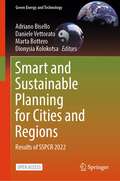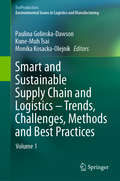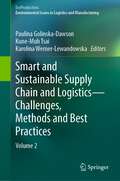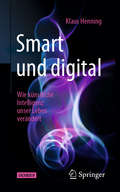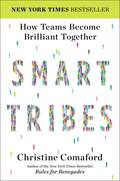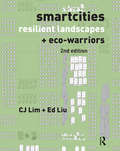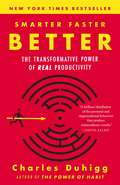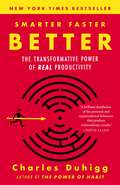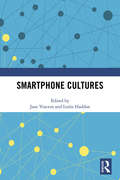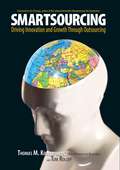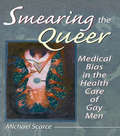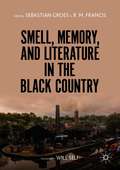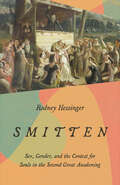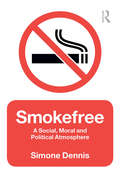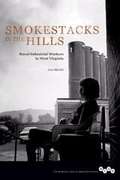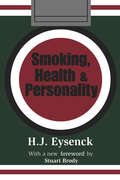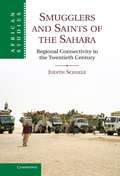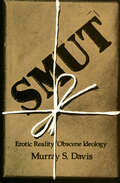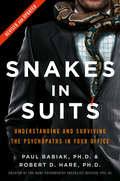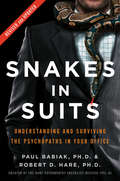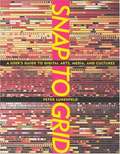- Table View
- List View
Smart and Sustainable Planning for Cities and Regions: Results of SSPCR 2022 (Green Energy and Technology)
by Dionysia Kolokotsa Adriano Bisello Daniele Vettorato Marta BotteroThis open access book includes a selection of innovative contributions presented at the 4th international conference “Smart and Sustainable Planning for Cities and Regions 2022”, held in Bolzano, Italy in July 2022. Featuring 10 papers by academics and consultants, strongly rooted in practical experiences and international projects, it discusses current ground-breaking research in innovative and sustainable planning for cities, with a focus on the environmental, economic, and social challenges associated with the global sustainability transition and energy systems integration. The contributions are illustrative of the richness of the issues discussed and the breadth of the emerging themes, including innovative business models for building and infrastructure at district level, integrated sustainability assessment schemes for Positive Energy Districts, a material flow accounting model for regional metabolism, energy communities as a lever to promote historical and landscape values, optimized and electrified last-mile logistics, multi-criteria decision analysis tools to redefine center/periphery relationships, a framework for socio-spatial analysis related to social practices, design principles and communication technologies improving both indoor and outdoor public spaces, augmented nature-based solution coupling the green elements with the latest technologies to deliver healthier and more appealing cities.
Smart and Sustainable Supply Chain and Logistics – Trends, Challenges, Methods and Best Practices: Volume 1 (EcoProduction)
by Paulina Golinska-Dawson Kune-Muh Tsai Monika Kosacka-OlejnikThis book discusses the critical contemporary issues of sustainability and integration of physical and information flow. It explores the digitalization of logistics processes and the need for a more integrated and a seamless cooperation in supply chain management, which are dominant trends in business practice. Moreover, it examines how the pressure for CO2 emission reductions and more resource- efficient business models influences the organization of logistics operations on both a local and global scale, demonstrating that integrating physical and cyber systems is necessary to achieve a more environmentally friendly, safe logistics and supply chain operations. In the individual chapters, the authors discuss the new qualitative and quantitative theoretical methods and models and also analyze case studies from business practice. This book provides valuable insights for academics, Ph.D. students and practitioners wishing to deepen their understanding of logistics operations and management.
Smart and Sustainable Supply Chain and Logistics — Challenges, Methods and Best Practices: Volume 2 (EcoProduction)
by Paulina Golinska-Dawson Karolina Werner-Lewandowska Kune-Muh TsaiThe application of artificial intelligence methods and the increasing digitalization of the processes in a supply chain contribute the more seamless flow of materials and information. The disturbances in global supply chain during pandemic put pressure on companies to improve the existing operations. The Sustainable Development Goals put pressure on local and global markets to reduce carbon dioxide emissions and to implement a more resource-efficient business model. Integration of physical and cyber systems is necessary to achieve more environmentally friendly, efficient logistics and supply chain operations. This book presents the contemporary issues of sustainability and integration of physical and information flow in supply chain. In the individual chapters, the authors discuss new qualitative and qualitative theoretic methods, models and present case studies from business practice. This book might be a valuable source of knowledge for the academics, PhD students and practitioners to deepen their knowledge in the field of logistics and SCM.
Smart und digital: Wie künstliche Intelligenz unser Leben verändert
by Klaus HenningKünstliche Intelligenz verändert alles.Dieses Buch ermutigt, sich der Herausforderung durch die digitale Transformation mit Künstlicher Intelligenz zu stellen. Der Leser erfährt, warum diese Transformation als größte Kulturrevolution seit der Erfindung des Massenbuchdrucks anzusehen ist und wie diese wert-orientiert positiv gestaltet werden kann. Dabei verfolgt der Autor die These, dass Intelligente Objekte im Netz und Gegenstände dieser Welt ein eigenes Bewusstsein bekommen. Er zeigt anhand vieler Beispiele, wie diese digitalen Begleiter zu unseren digitalen Partnern werden. Dieses Sachbuch gibt viele Anregungen für das eigene Lebens- und Arbeitsumfeld und ist voller Beispiele für die Umsetzung von Systemen der künstlichen Intelligenz. Der Leser erfährt, was heute schon geht und was in den nächsten zehn bis zwanzig Jahren zu erwarten ist. Das Werk ist für alle interessant, die sich für KI und die digitale Transformation interessieren – von Verantwortlichen in Unternehmen, öffentlichen Einrichtungen und Politik, wie auch alle Lehrer und Eltern, die verstehen wollen, was die nächste Generation erwartet.
SmartTribes
by Christine ComafordAre You Scaring Your People into Mediocrity? All leaders want to outperform, outsell, and outinnovate the competition. And most teams are fully capable of doing so. The problem: we consistently say and do things that spark unconscious fears and keep our people stuck in their Critter State. This primitive fight, flight, or freeze mode distills all decision making to one question: What will keep me safest? Lying low, sucking up, procrastinating, and doing a good enough job may keep employees breathing, but it doesn't make for vital organizations. Leaders have to get their people unstuck and fully engaged, replacing their old, limiting mental patterns with new patterns that foster optimal performance. New York Times bestselling author and applied neuroscience expert Christine Comaford knows what it takes to move people from the Critter State into the Smart State, where they have full access to their own creativity, innovation, higher consciousness, and emotional engagement. When an entire culture maintains that state, it becomes what she calls a SmartTribe. Focused. Accountable. Collaborative. Imbued with the energy and passion to solve problems and do what needs doing, again and again and again. Comaford brings to this book more than thirty years of company-building experience, combined with her expertise in behavioral modification and organizational development. She has helped hundreds of leaders navigate rapid growth, maximize performance, resolve internal conflicts, and execute turnarounds with the full support of their people. Now she shares potent yet easy-to-learn neuroscience techniques that will help you do the same. You'll learn how to move your team forward and reach your next revenue inflection point using the five key Accelerators of the Smart State--focus, clarity, accountability, influence, and sustainability. You'll get better at anticipating and moving through your own stuck spots and those of your people. Using her proven system, Comaford's clients have already created hundreds of millions of dollars in new value. They've seen their revenues and profits increase by up to 210% annually; individuals become up to 50% more productive and 100% more accountable; marketing demand generation grow by up to 237%; new products and services created up to 48% faster; and sales close up to 50% faster. They spot changes in their markets more quickly, then pounce on them to create the future they want. Ultimately, SmartTribes will help you and your team achieve optimal performance and engagement--brilliance--and leave competitors in the dust.
SmartTribes: How Teams Become Brilliant Together
by Christine ComafordAre You Scaring Your People into Mediocrity? All leaders want to outperform, outsell, and outinnovate the competition. And most teams are fully capable of doing so. The problem: we consistently say and do things that spark unconscious fears and keep our people stuck in their Critter State. This primitive fight, flight, or freeze mode distills all decision making to one question: What will keep me safest? Lying low, sucking up, procrastinating, and doing a good enough job may keep employees breathing, but it doesn’t make for vital organizations. Leaders have to get their people unstuck and fully engaged, replacing their old, limiting mental patterns with new patterns that foster optimal performance. New York Times bestselling author and applied neuroscience expert Christine Comaford knows what it takes to move people from the Critter State into the Smart State, where they have full access to their own creativity, innovation, higher consciousness, and emotional engagement. When an entire culture maintains that state, it becomes what she calls a SmartTribe. Focused. Accountable. Collaborative. Imbued with the energy and passion to solve problems and do what needs doing, again and again and again. Comaford brings to this book more than thirty years of company-building experience, combined with her expertise in behavioral modification and organizational development. She has helped hundreds of leaders navigate rapid growth, maximize performance, resolve internal conflicts, and execute turnarounds with the full support of their people. Now she shares potent yet easy-to-learn neuroscience techniques that will help you do the same. You’ll learn how to move your team forward and reach your next revenue inflection point using the five key Accelerators of the Smart State-focus, clarity, accountability, influence, and sustainability. You’ll get better at anticipating and moving through your own stuck spots and those of your people. Using her proven system, Comaford’s clients have already created hundreds of millions of dollars in new value. They’ve seen their revenues and profits increase by up to 210% annually; individuals become up to 50% more productive and 100% more accountable; marketing demand generation grow by up to 237%; new products and services created up to 48% faster; and sales close up to 50% faster. They spot changes in their markets more quickly, then pounce on them to create the future they want. Ultimately, SmartTribes will help you and your team achieve optimal performance and engagement-brilliance-and leave competitors in the dust. .
Smartcities, Resilient Landscapes and Eco-Warriors: Resilient Landscapes + Eco-warriors
by Ed Liu CJ LimFollowing on from the success of the first edition, Smartcities + Eco-Warriors (2010), this book is the latest innovative response on urban resilience from one of the world’s leading urban design and architectural thinkers. An ecological symbiosis between nature, society and the built form, the Smartcity cultivates new spatial practices and creates diverse forms of resilient landscapes including and beyond urban agriculture. The notion of the Smartcity is developed through a series of international case studies, some commissioned by government organisations, others speculative and polemic. This second edition has nine new case studies, and additional ecological sustainability studies covering sensitivity, design criteria, and assessments for ecological construction plans. The book concludes with two new essays on the romance of trees and the empowering nature of resilient landscapes. Smartcities, Resilient Landscapes + Eco-warriors represents a crucial voice in the discourse of climate change and the potential opportunities to improve the ecological function of existing habitats or create new landscapes which are considered beneficial to local ecology and resilience. It is indispensable reading for practitioners and students in the fields of landscape, urban design, architecture and environmental engineering. An inspiration to government agencies and NGOs dealing with sustainability, this work also resonates with anyone concerned about cities, landscapes, food and water security, and energy conservation.
Smarter Faster Better
by Charles Duhigg<P>From the bestselling author of The Power of Habit comes a fascinating new book exploring the science of productivity, and why, in today's world, managing how you think--rather than what you think about--can transform your life. <P>Productivity, recent studies suggest, isn't always about driving ourselves harder, working faster and pushing ourselves toward greater "efficiency." Rather, real productivity relies on managing how we think, identify goals, construct teams and make decisions. The most productive people, companies and organizations don't merely act differently--they envision the world and their choices in profoundly different ways. <P> This book explores eight concepts that are critical to increasing productivity. It takes you into the cockpit of two passenger jets (one crashes) to understand the importance of constructing mental models--telling yourself stories about yourself in order to subconsciously focus on what really matters. <P>It introduces us to basic training in the U.S. Marine Corps, where the internal locus of control is exploited to increase self-motivation. ' <P>It chronicles the outbreak of Israel's Yom Kippur War to examine cognitive closure--a dangerous trap that stems from our natural desire to feel productive and check every last thing off our to-do lists, causing us to miss obvious risks and bigger opportunities. <P>It uses a high-achieving public school in Cincinnati to illuminate the concept of disfluency, which holds that we learn faster and more deeply when we make the data harder to absorb. <P>It shows how the principles of lean manufacturing--in which decision-making power is pushed to the lowest levels of the hierarchy--allowed the FBI to produce a software system that had eluded them for years. <P>It explores how Disney made Frozen into a record success by encouraging tension among animation teams--a version of what biologists refer to as the Intermediate Disturbance Hypothesis, which posits that nature is most creative when crises occur. <P>With the combination of relentless curiosity, deep reporting and rich storytelling that defined The Power of Habit, Charles Duhigg takes readers from neurology laboratories to Google's brainstorming sessions and illustrates how we can all increase productivity in our lives. <P><b>A New York Times Bestseller</b>
Smarter Faster Better: The Transformative Power of Real Productivity
by Charles Duhigg<P>From the author of the New York Times bestselling phenomenon The Power of Habit comes a fascinating new book that explores the science of productivity, and why, in today's world, managing how you think--rather than what you think--can transform your life. <P>A young woman drops out of a PhD program and starts playing poker. By training herself to envision contradictory futures, she learns to anticipate her opponents' missteps--and becomes one of the most successful players in the world. <P>A group of data scientists at Google embark on a four-year study of how the best teams function, and find that how a group interacts is more important than who is in the group--a principle, it turns out, that also helps explain why Saturday Night Live became a hit. A Marine Corps general, faced with low morale among recruits, reimagines boot camp--and discovers that instilling a "bias toward action" can turn even the most directionless teenagers into self-motivating achievers. The filmmakers behind Disney's Frozen are nearly out of time and on the brink of catastrophe--until they shake up their team in just the right way, spurring a creative breakthrough that leads to one of the highest-grossing movies of all time. <P>What do these people have in common? They know that productivity relies on making certain choices. <P>The way we frame our daily decisions; the big ambitions we embrace and the easy goals we ignore; the cultures we establish as leaders to drive innovation; the way we interact with data: These are the things that separate the merely busy from the genuinely productive. At the core of Smarter Faster Better are eight key concepts--from motivation and goal setting to focus and decision making--that explain why some people and companies get so much done. <P>Drawing on the latest findings in neuroscience, psychology, and behavioral economics--as well as the experiences of CEOs, educational reformers, four-star generals, FBI agents, airplane pilots, and Broadway songwriters--this painstakingly researched book explains that the most productive people, companies, and organizations don't merely act differently. They view the world, and their choices, in profoundly different ways.<P>In The Power of Habit, Pulitzer Prize-winning journalist Charles Duhigg explained why we do what we do. In Smarter Faster Better, he applies the same relentless curiosity, deep reporting, and rich storytelling to explain how we can improve at the things we do. It's a groundbreaking exploration of the science of productivity, one that can help anyone learn to succeed with less stress and struggle, and to get more done without sacrificing what we care about most--to become smarter, faster, and better at everything we do. <P><b>A New York Times Bestseller</b>
Smartphone Cultures
by Jane Vincent Leslie HaddonSmartphone Cultures explores emerging questions about the ways in which this mobile technology and its apps have been produced, represented, regulated and incorporated into everyday social practices. The various authors in this volume each locate their contributions within the circuit of culture model. More specifically, this book engages with issues of production and regulation in the case of the electrical infrastructure supporting smartphones and the development of mobile social gambling apps. It examines issues of consumption through looking at parental practices relating to children’s smartphone use, children’s experience of the regulation of this technology, both in the home and in school, how they cope with the mass of communications via the smartphone and the nature of their attachment to the device. Other chapters cover the engagement of older people with smartphones, as well as how different cultural norms of sociability have a bearing on how the technology is consumed. The smartphone’s implications for other theoretical frameworks is illustrated through examining ramifications for domestication, and the sometimes-limited place of smartphones in certain aspects of life is examined through its role in the practices of reading and writing. Smartphone Cultures presents the latest international research from scholars located in the UK, Europe, the US and Australia and will appeal to scholars and students of media and cultural studies, communication studies and sociologists with interests in technology and social practices.
Smartsourcing: Driving Innovation And Growth Through Outsourcing
by Thomas M KoulopoulosOutsourcing is the most popular movement of the new global business economy. In fact, the typical executive will soon spend one-third of their budget on outsourcing! Smartsourcing is the next evolution in outsourcing. Traditional outsourcing reduces costs by moving the work to where the least expensive workers are. While that may cut costs, it simply replicates the status quo. Smartsourcing goes a step further by showing companies how to partner with service providers to not only cut costs, but also increase innovation across the full spectrum of their business. Smartsourcing is the first book on the market to be ahead of the curve on one of the most important shifts in business today.
Smearing the Queer: Medical Bias in the Health Care of Gay Men
by Michael ScarceDiscover how gay men’s health care can be improved!Smearing the Queer: Medical Bias in the Health Care of Gay Men explores how social prejudices embedded in scientific research and practice often act as a detriment to gay men’s health. This book provides an agenda for addressing heterosexism in the health sciences and in medical care while broadening approaches to gay male wellness beyond the limited scope of HIV infection. This groundbreaking book explore a number of neglected concerns affecting the sexual health of gay men , calling for the recognition of their scientific, political, and cultural significance. In Smearing the Queer, gay men, HIV prevention workers, health care providers, mental health professionals, policymakers, researchers, and instructors in related fields will appreciate the in-depth examination of such issues as: research and development on rectal microbicides why many gay men should be receiving periodic anal Pap smears to screen for anorectal cancer an in-depth critique of the problematic diagnosis of “Gay Bowel Syndrome” gay men’s use of the Reality Female Condom for anal sex Viagara’s impact on gay men’s sexual cultures, erectile dysfunction, and recreational drug use a broad-based advocacy agenda for improving relations between gay men and the health sciences the politics surrounding gay men’s restricted access to new and prospective safer sex technologies Smearing the Queer challenges heterosexist bias within the health care delivery and health sciences research and calls for the development of public policy initiatives that address gay men’s wellness in more sophisticated and complex ways. This is the only publication that provides in-depth social, cultural, and political analysis of the topics of Gay Bowel Syndrome, gay men’s use of the female condom, rectal microbicides, and anal Pap smears while examining the social forces that direct scientific research under the guise of objectivity.
Smell, Memory, and Literature in the Black Country
by Sebastian Groes R. M. FrancisFrom Banks’s brewery’s yeasty stink to groaty pudding to spicy curry, Sebastian Groes and R. M. Francis have assembled a new literary history of the smells and (childhood) memories that belong to the Black Country. This often overlooked region of the United Kingdom at the frontlines of post-industrial upheaval is a veritable treasure trove for studying the relationship between olfaction and place-specific memory. Smell, Memory, and Literature in the Black Country is an interdisciplinary exploration of the relationship between smell and memory in which the contributions consider both personal and communal memory. Drawing on psychology, neuroscience, memory studies, literary studies and philosophy, the critical essays reconsider psychogeography through cutting-edge sensory and philosophical engagements with physical space, smell, language and human behaviour. The creative contributions from writers including Liz Berry, Narinder Dhami, Anthony Cartwright, and Kerry Hadley-Pryce meditate on the senses, place, and identity. Not only does this book illustrate the rich cultural heritage of the Black Country, it will also appeal to those interested in place writing. The book is prefaced by Will Self.
Smitten: Sex, Gender, and the Contest for Souls in the Second Great Awakening
by Rodney HessingerIn Smitten, Rodney Hessinger examines how the Second Great Awakening disrupted gender norms across a breadth of denominations. The displacement and internal migration of Americans created ripe conditions for religious competition in the North. Hessinger argues that during this time of religious ferment, religious seekers could, in turn, play the missionary or the convert. The dynamic of religious rivalry inexorably led toward sexual and gender disruption. Contending within an increasingly democratic religious marketplace, preachers had to court converts in order to flourish. They won followers through charismatic allure and making concessions to the desires of the people. Opening their own hearts to new religious impulses, some religious visionaries offered up radical dispensations—including new visions of how God wanted them to reorder sex and gender relations in society. A wide array of churches, including Methodists, Baptists, Mormons, Shakers, Catholics, and Perfectionists, joined the fray. Religious contention and innovation ultimately produced backlash. Charges of seduction and gender trouble ignited fights within, among, and against churches. Religious opponents insisted that the newly converted were smitten with preachers, rather than choosing churches based on reason and scripture. Such criticisms coalesced into a broader pan-Protestant rejection of religious enthusiasm. Smitten reveals the sexual disruptions and subsequent domestication of religion during the Second Great Awakening.
Smoke Hole: Looking to the Wild in the Time of the Spyglass
by Martin Shaw"With potent, lyrical language and a profound knowledge of storytelling, Shaw encourages and illuminates the mythic in our own lives. He is a modern-day bard." – Madeline Miller, author of Circe and The Song of Achilles At a time when we are all confronted by not one, but many crossroads in our modern lives—identity, technology, trust, politics, and a global pandemic—celebrated mythologist and wilderness guide Martin Shaw delivers Smoke Hole: three metaphors to help us understand our world, one that is assailed by the seductive promises of social media and shadowed by a health crisis that has brought loneliness and isolation to an all-time high. Smoke Hole is a passionate call to arms and an invitation to use these stories to face the complexities of contemporary life, from fake news, parenthood, climate crises, addictive technology and more. Shaw urges us to reclaim our imagination and untangle ourselves from modern menace, letting these tales be our guide. More Praise: "I can still remember the first time I heard Martin Shaw tell a story. The tale that emerged was like a living thing, bounding around, throwing itself at us there listening. I had never heard anything like it before." – Paul Kingsnorth, Booker shortlisted author of The Wake "Martin Shaw’s work is so very beautiful. A new animal. His love of images is deep and contagious." – Coleman Barks, author of The Essential Rumi "Through feral tales and poetic exegesis, Martin Shaw makes you re-see the world, as a place of adventure, and of initiation, as perfect home, and as perfectly other. What a gift." – David Keenan, author of Xstabeth "Shaw has so much wisdom and knowledge about the old stories, it emanates from his pores." – John Densmore, The Doors
Smokefree: A Social, Moral and Political Atmosphere
by Simone DennisAlthough tobacco is a legal substance, many governments around the world have introduced legislation to restrict smoking and access to tobacco products. Smokefree critically examines these changes, from the increasing numbers of places being designated as ‘smokefree’ to changes in cigarette packaging and the portrayal of smoking in popular culture. Unlike existing texts, this book neither advances a public health agenda nor condemns the erosion of individual rights. Instead, Simone Dennis takes a classical anthropological approach to present the first agenda-free, full-length study of smoking. Observing and analysing smoking practices and environments, she investigates how the social, moral, political and legal atmosphere of ‘smokefree’ came into being and examines the ideas about smoke, air, the senses, space, and time which underlie it. Looking at the impact on public space and individuals, she reveals broader findings about the relationship between the state, agents, and what is seen to constitute ‘the public’. Enriched with ethnographic vignettes from the author’s ten years of fieldwork in Australia, Smokefree is a challenging, important book which demands to be read and discussed by anyone with an interest in anthropology, sociology, political science, human geography, and public health.
Smokestacks in the Hills: Rural-Industrial Workers in West Virginia (The Working Class in American History)
by Lou MartinLong considered an urban phenomenon, industrialization also transformed the American countryside. Lou Martin weaves the narrative of how the relocation of steel and pottery factories to Hancock County, West Virginia, created a rural and small-town working class--and what that meant for communities and for labor. As Martin shows, access to land in and around steel and pottery towns allowed residents to preserve rural habits and culture. Workers in these places valued place and local community. Because of their belief in localism, an individualistic ethic of "making do," and company loyalty, they often worked to place limits on union influence. At the same time, this localism allowed workers to adapt to the dictates of industrial capitalism and a continually changing world on their own terms--and retain rural ways to a degree unknown among their urbanized peers. Throughout, Martin ties these themes to illuminating discussions of capital mobility, the ways in which changing work experiences defined gender roles, and the persistent myth that modernizing forces bulldozed docile local cultures. Revealing and incisive, Smokestacks in the Hills reappraises an overlooked stratum of American labor history and contributes to the ongoing dialogue on shifts in national politics in the postwar era.
Smoking Environments in China: Challenges for Tobacco Control (Global Perspectives on Health Geography)
by Ross Barnett Tingzhong Yang Xiaozhao Y. YangThis book fills a major gap in research into smoking and tobacco control in China. In recent decades, few studies have explored the significance of geographical factors and the role they have played either in affecting the prevalence of smoking or in tobacco control responses to the smoking epidemic in China. In light of this, the book investigates the importance of national, regional and local environmental factors affecting smoking in China. It shows how geographical, social and institutional contexts have influenced the implementation and success of tobacco control initiatives, and situates smoking trends in China in a broader global context. The authors synthesize Chinese and western research on the smoking epidemic and uniquely focus on the importance of environmental factors and Chinese cultural perspectives in understanding smoking behaviour and the ineffectiveness of many tobacco control initiatives, especially how these conflict with Chinese economic policy. The book is aimed at academic and policy audiences both internationally and inside China, and will be of interest to a wide audience, not only geographers, but also epidemiologists, sociologists and others working in public health.
Smoking, Health and Personality
by Hans EysenckThe Report on Smoking and Health published by the Royal College of Physicians in England in 1965 warned of a connection between lung -cancer and smoking. The findings were widely publicized, and were accepted by practically every-one-indeed, they persist today. As Hans J. Eysenck shows in his classic study Smoking, Health, and Personality, the results were by no means immune to challenge. Not only were the experimental and statistical methods employed vulnerable to criticism, but the results were open to more than one interpretation.In this new edition, Stuart Brody reviews Eysenck's achievement. Eysenck critically reviewed the literature, presented longitudinal studies showing that psychological characteristics are far more potent predictors of heart disease and cancer than smoking behavior, and demonstrated that psychological treatment can halve death rates. Eysenck also spoke the unspeakable, iconoclastically attacking the cherished attribution of millions of deaths to smoking. He examined the interaction of smoking with personality and constitutional factors, and the connection between these factors and the development of cancer. Eysenck saw the cause-and-effect relation between cancer and smoking as oversimplification. He also makes a number of practical suggestions for the kind of social action that could be taken to decrease the incidence of lung cancer. For his part, Brody notes that massive campaigns which exhort people to eschew tobacco or cholesterol have had little or no demonstrable health benefits.This original and stimulating volume is written with great clarity and is easily understood by the layman. It is an incisive account of one of the most important social problems in this country today, and a challenge to orthodoxy in the medical world. As such, this volume offers much for both sides of the anti-smoking lobby, as well as those in the fields of psychology, political science, and sociology. .
Smoother Pebbles: Essays in the Sociology of Science
by Jonathan R. ColeUntil the middle of the twentieth century, few thought of science as a social system, instead seeing scientific discovery as the work of individual geniuses. Columbia University’s Department of Sociology played a pivotal role in advancing the social study of science. Researchers of the “Columbia Program” analyzed how science works as a social institution, exploring its norms, values, and structure.Smoother Pebbles presents a collection of essays authored or coauthored by Jonathan R. Cole, a leading Columbia Program figure, that trace the development and institutionalization of the sociology of science. Spanning from the 1960s to the 2020s and including both empirical and theoretical studies of science, the book is at once wide-ranging and united by core questions. Are scientists rewarded for the merits of their work or for other reasons? How does the system of social stratification in science operate? Has the funding of scientists been the result of an “old boys’ network”? How fair is the peer review process? In what ways does science fall short of its universalistic ideals? What factors have constrained opportunities for women in science? How has science fared amid attacks on academic freedom and free inquiry at universities? Cole’s introduction contextualizes both individual essays and the major concerns of the Columbia Program. Smoother Pebbles is essential reading for those interested in the growth and crucial questions of the sociology and social studies of science.
Smugglers and Saints of the Sahara
by Judith ScheeleSmugglers and Saints of the Sahara describes life on and around the contemporary border between Algeria and Mali, exploring current developments in a broad historical and socioeconomic context. Basing her findings on long-term fieldwork with trading families, truckers, smugglers and scholars, Judith Scheele investigates the history of contemporary patterns of mobility from the late nineteenth century to the present. Through a careful analysis of family ties and local economic records, this book shows how long-standing mobility and interdependence have shaped not only local economies, but also notions of social hierarchy, morality and political legitimacy, creating patterns that endure today and that need to be taken into account in any empirically-grounded study of the region.
Smut: Erotic Reality/Obscene Ideology
by Murray S. DavisThis unique study of sexuality and society offers a provocative reframing of the subject—including what the author calls a periodic table of perversions. In Smut, Murray S. Davis investigates sex in a way that differs from nearly all previous books on the subject. Discarding the simplistic theory of sex as a natural instinct, he sets out to develop new explanations for its universal appeal. Drawing on a wide variety of literary forms, including the work of novelists, poets, and even comedians—and exploring everything from theology to pornography—Davis recaptures sex for the social sciences. First, Davis examines the difference between sexual arousal and ordinary experience, arguing that arousal alters a person's experience of the world. Positing an erotic reality distinct from everyday life, he demonstrates how different perceptions of time, space, human bodies, and other social types occur in each realm. Davis then asks why some people find this alternation between realities dirty, and offers a periodic table of perversions that summarizes the social elements out of which those who find sex dirty construct their world. Finally, Davis considers other conceptual grids affected by the alternation between everyday and erotic realities: the pornographic, which portrays individual, social relations, and social organizations being disrupted by sex; and the naturalistic, which conceives of them in a way that cannot be disrupted by sex. Throughout history these ideologies have battled for control over Western society, and, in his conclusion, Davis offers a prognosis for the future of sex based on these historical ideological cycles.
Snakes in Suits
by Robert D. Hare Paul BabiakLet's say you're about to hire somebody for a position in your company. Your corporation wants someone who's fearless, charismatic, and full of new ideas. Candidate X is charming, smart, and has all the right answers to your questions. Problem solved, right? Maybe not. We'd like to think that if we met someone who was completely without conscience -- someone who was capable of doing anything at all if it served his or her purposes -- we would recognize it. In popular culture, the image of the psychopath is of someone like Hannibal Lecter or the BTK Killer. But in reality, many psychopaths just want money, or power, or fame, or simply a nice car. Where do these psychopaths go? Often, it's to the corporate world. Researchers Paul Babiak and Robert Hare have long studied psychopaths. Hare, the author of Without Conscience, is a world-renowned expert on psychopathy, and Babiak is an industrial-organizational psychologist. Recently the two came together to study how psychopaths operate in corporations, and the results were surprising. They found that it's exactly the modern, open, more flexible corporate world, in which high risks can equal high profits, that attracts psychopaths. They may enter as rising stars and corporate saviors, but all too soon they're abusing the trust of colleagues, manipulating supervisors, and leaving the workplace in shambles. Snakes in Suits is a compelling, frightening, and scientifically sound look at exactly how psychopaths work in the corporate environment: what kind of companies attract them, how they negotiate the hiring process, and how they function day by day. You'll learn how they apply their "instinctive" manipulation techniques -- assessing potential targets, controlling influential victims, and abandoning those no longer useful -- to business processes such as hiring, political command and control, and executive succession, all while hiding within the corporate culture. It's a must read for anyone in the business world, because whatever level you're at, you'll learn the subtle warning signs of psychopathic behavior and be able to protect yourself and your company -- before it's too late.
Snakes in Suits, Revised Edition: Understanding and Surviving the Psychopaths in Your Office
by Dr. Paul Babiak Dr. Robert D. HareRevised and updated with the latest scientific research and updated case studies, the business classic that offers a revealing look at psychopaths in the workplace—how to spot their destructive behavior and stop them from creating chaos in the modern corporate organization.Over the past decade, Snakes in Suits has become the definitive book on how to discover and defend yourself against psychopaths in the office. Now, Dr. Paul Babiak and Dr. Robert D. Hare return with a revised and updated edition of their essential guide.All of us at some point have—or will—come into contact with psychopathic individuals. The danger they present may not be readily apparent because of their ability to charm, deceive, and manipulate. Although not necessarily criminal, their self-serving nature frequently is destructive to the organizations that employ them. So how can we protect ourselves and our organizations in a business climate that offers the perfect conditions for psychopaths to thrive?In Snakes in Suits, Hare, an expert on the scientific study of psychopathy, and Babiak, an industrial and organizational psychologist and a leading authority on the corporate psychopath, examine the role of psychopaths in modern corporations and provide the tools employers can use to avoid and deal with them. Together, they have developed the B-Scan 360, a research tool designed specifically for business professionals.Dr. Babiak and Dr. Hare reveal the secret lives of psychopaths, explain the ways in which they manipulate and deceive, and help you to see through their games. The rapid pace of today’s corporate environment provides the perfect breeding ground for these "snakes in suits" and this newly revised and updated classic gives you the insight, information, and power to protect yourself and your company before it’s too late.
Snap to Grid: A User's Guide to Digital Arts, Media, and Cultures
by Peter LunenfeldIn Snap to Grid, an idiosyncratic guide to the interactive, telematic era, Peter Lunenfeld maps out the trajectories that digital technologies have traced upon our cultural imaginary.
